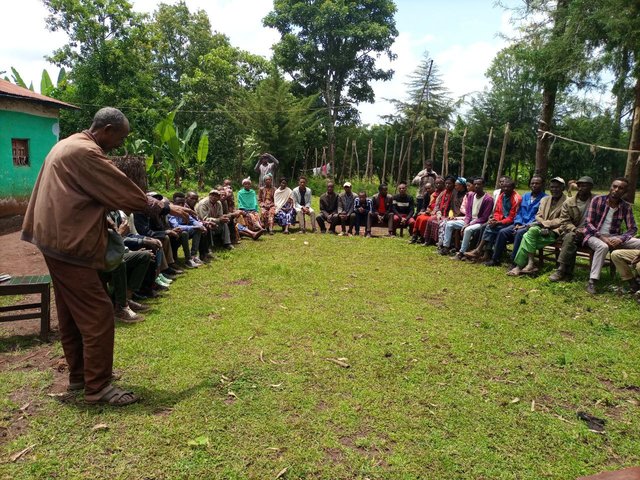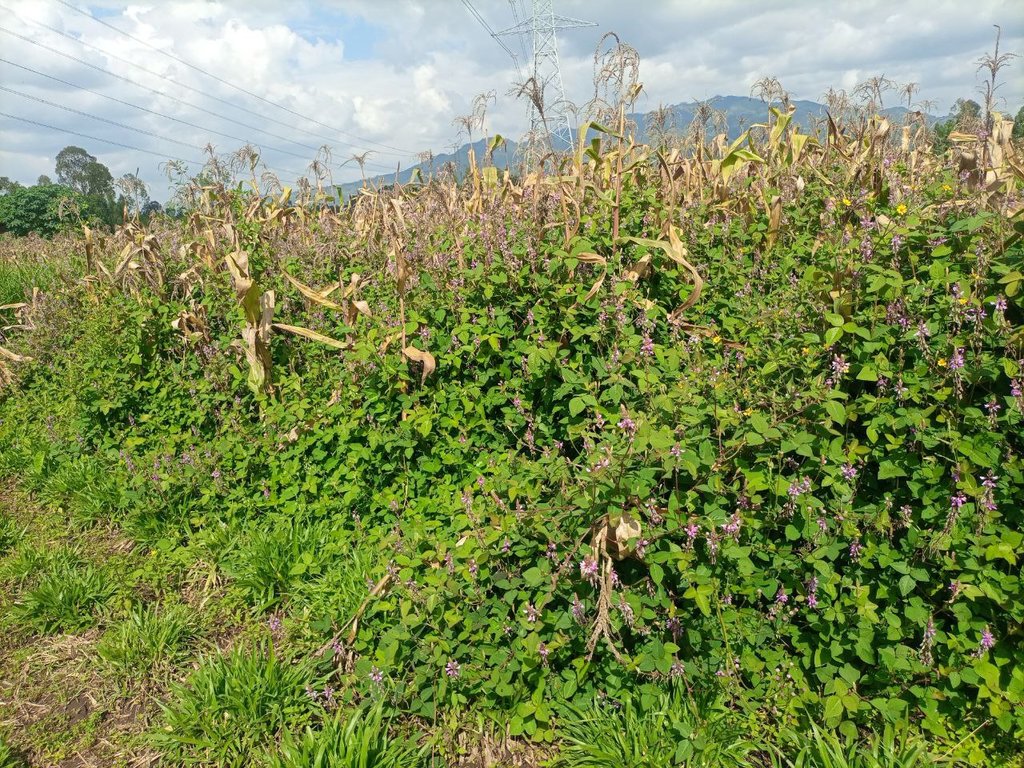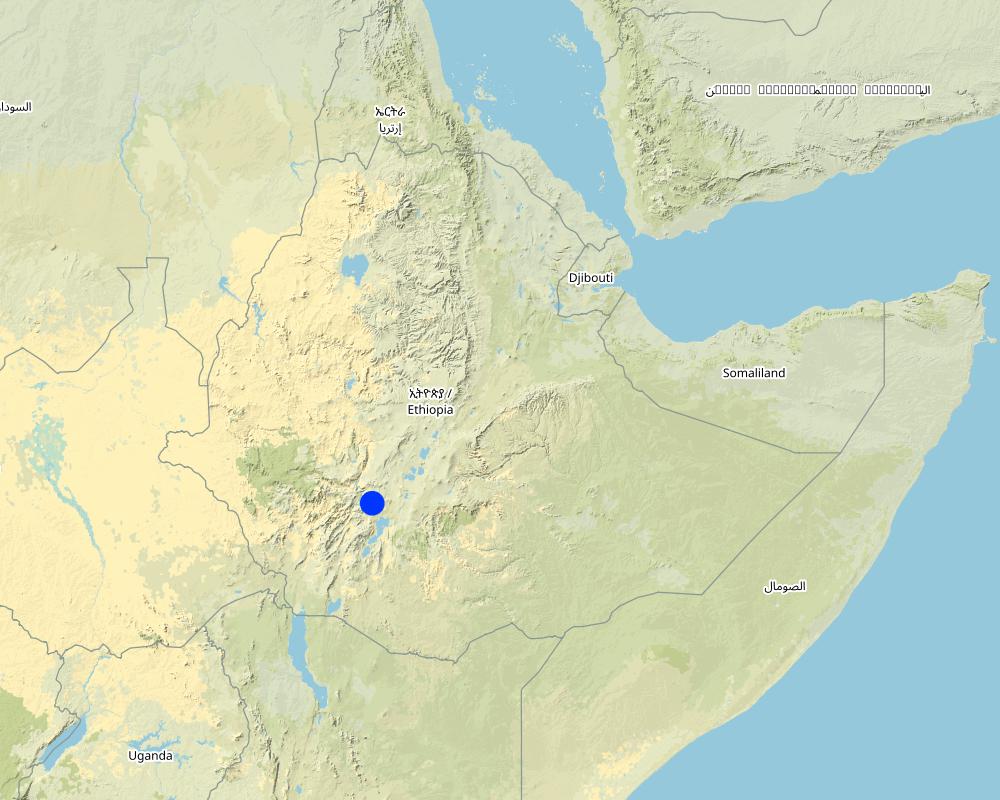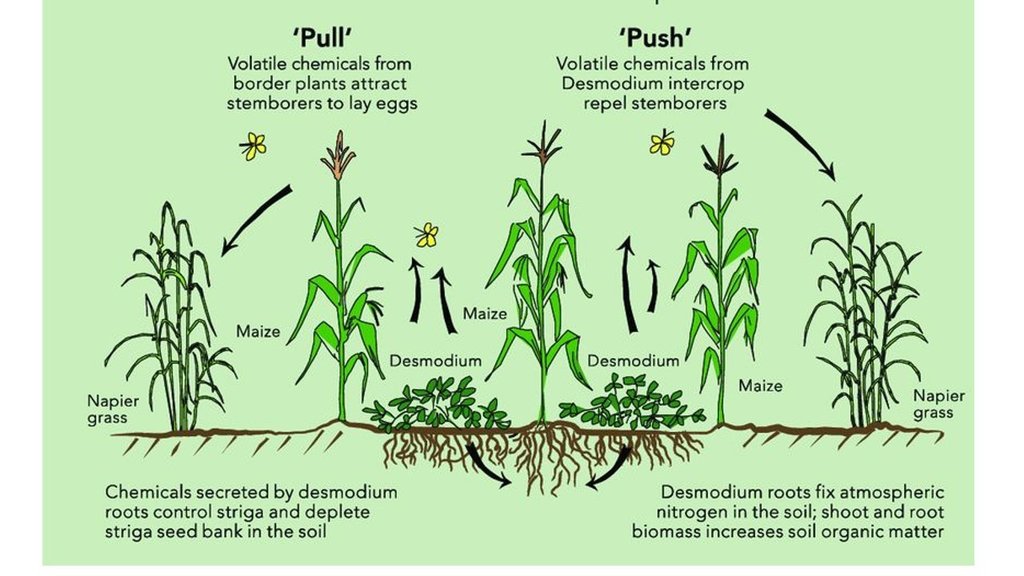Cover crops [ប្រទេសអេត្យូពី]
- ការបង្កើត៖
- បច្ចុប្បន្នភាព
- អ្នកចងក្រង៖ GERBA LETA
- អ្នកកែសម្រួល៖ Julia Doldt, Kidist Yilma, Noel Templer
- អ្នកត្រួតពិនិត្យច្រើនទៀត៖ William Critchley, Rima Mekdaschi Studer
Yeshifan Sebil (in Amharic)
technologies_6628 - ប្រទេសអេត្យូពី
ពិនិត្យមើលគ្រប់ផ្នែក
ពង្រីកមើលទាំងអស់ បង្រួមទាំងអស់1. ព័ត៌មានទូទៅ
1.2 ព័ត៌មានលម្អិតពីបុគ្គលសំខាន់ៗ និងស្ថាប័នដែលចូលរួមក្នុងការវាយតម្លៃ និងចងក្រងឯកសារនៃបច្ចេកទេស
បុគ្គលសំខាន់ម្នាក់ (ច្រើននាក់)
អ្នកប្រើប្រាស់ដី:
Falaha Fanaye
Farmer
ប្រទេសអេត្យូពី
ឈ្មោះគម្រោងដែលបានចងក្រងឯកសារ/ វាយតម្លៃលើបច្ចេកទេស (បើទាក់ទង)
Soil protection and rehabilitation for food security (ProSo(i)l)ឈ្មោះអង្គភាពមួយ (ច្រើន) ដែលបានចងក្រងឯកសារ/ វាយតម្លៃបច្ចេកទេស (បើទាក់ទង)
Alliance Bioversity and International Center for Tropical Agriculture (Alliance Bioversity-CIAT) - ប្រទេសកេនយ៉ា1.3 លក្ខខណ្ឌទាក់ទងទៅនឹងការប្រើប្រាស់ទិន្នន័យដែលបានចងក្រងតាមរយៈ វ៉ូខេត
អ្នកចងក្រង និង(បុគ្គលសំខាន់ៗ)យល់ព្រមទទួលយកនូវលក្ខខណ្ឌនានាទាក់ទងទៅនឹងការប្រើប្រាស់ទិន្នន័យដែលបានចងក្រងតាមរយៈវ៉ូខេត:
បាទ/ចា៎
1.4 សេចក្តីប្រកាសស្តីពីចីរភាពនៃការពណ៌នាពីបច្ចេកទេស
តើបច្ចេកទេសដែលបានពណ៌នានេះមានបញ្ហាដែលផ្តោតលើការធ្លាក់ចុះគុណភាពដី, បើដូច្នេះវាមិនអាចត្រូវបានប្រកាសថាជាបច្ចេកទេសនៃការគ្រប់គ្រងប្រកបដោយចីរភាពទេ?
ទេ
មតិយោបល់:
With good management, a legume known as desmodium is a very good cover crop that can be integrated into perennial and annual crops. It improves soil fertility, repels insects and caters feed to the livestock.
1.5 ការយោងទៅលើកម្រងបញ្ជីសំណួរ (មួយ ឬច្រើន) នៃវិធីសាស្ត្រផ្សព្វផ្សាយ SLM (ដែលបានចងក្រងដោយទស្សនៈពិភពលោកស្តីពីវិធីសាស្ត្រ និងបច្ចេកទេសងអភិរក្ស WOCAT)

Farmers Research and Extension Group (FREG) [ប្រទេសអេត្យូពី]
A Farmers Research and Extension Group (FREG) engages about 50 or more farmers in a kebele (lower administrative unit), with three sub groups of 17-20 each who live in a homogenous landscape. It is a local institution established for joint learning, piloting, and evaluating soil improvement technologies across the intervention …
- អ្នកចងក្រង៖ GERBA LETA
2. ការពណ៌នាពីបច្ចេកទេស SLM
2.1 ការពណ៌នាដោយសង្ខេបពីបច្ចេកទេស
និយមន័យបច្ចេកទេស:
Cover crops are crops grown on bare, fallow farmland or under a main crop to cover and conserve the soil by protecting it from exposure to the sun, wind, and direct impact of rain. It fixes nitrogen (if a legume), improves soil fertility, supplies livestock fodder, and helps manage both pests and weeds.
2.2 ការពណ៌នាលម្អិតពីបច្ចេកទេស
ការពណ៌នា:
Cover crops are planted to conserve the soil on bare, fallow farmland or under a main crop. They can be grown on their own or between rows of annual and perennial crops such as maize, coffee, and fruits. The main purposes of growing cover crops are to cover the soil with low-growing vegetation, protect the soil from exposure to sun and rain, suppress weeds, improve soil fertility, supply livestock feed, and manage insect pests. Cover crops may be nitrogen fixing (if legumes), and they make productive use of spaces between crop rows, as well as controlling wind and water erosion. They also have the potential to restore soil fertility and help in climate change adaptation, as well as sequestration of atmospheric carbon above and below soil surface. Furthermore, cover crops can be fed to livestock, helping to bridge periods of shortage of feed when grazing lands are not available – which is an increasing problem because of growing population pressure and expansion of croplands. Land users give huge credit for its role as a pesticide by deterring armyworm and stalk borer when used as a border, and stopping their advance into the maize crop.
Desmodium is an example of a leguminous cover crop, improving soil fertility via fixing atmospheric nitrogen, increasing infiltration and productive use of soil moisture, and catering for livestock via a “cut-and-carry” fodder system. Desmodium is planted between rows of maize crops as well as between grass hedgerows around the farm. For its establishment, access to desmodium seed is essential. Once established, it remains to serve as a permanent source of planting material. Nevertheless, there are some disadvantages of desmodium: seed collection is difficult, it may trap honey bees and it can compete with the crop for light and space if allowed to grow too tall. Thus, efficient management of desmodium is essential. Nevertheless, as part of an agro-ecological intervention, cover crops like desmodium deliver multiple benefits to resource-poor farmers and can be viewed as an investment in improving soil fertility as well as soil health. Overall, cover crops improve productivity, and help ensure yield stability and contribute to a healthier ecosystem.
2.3 រូបភាពនៃបច្ចេកទេស
កំណត់សម្គាល់ទូទៅនៃរូបថត/រូភាព:
The photo portrays the location where desmodium and other grass species mutually play distinct but complementary push-pull roles of attracting and repelling insect pests from infesting the main crop past the visible hedgerows.
2.4 វីដេអូនៃបច្ចេកទេស
ការពណ៌នាសង្ខេប:
Videos of this technology is not taken.
2.5 ប្រទេស/តំបន់/ទីតាំងកន្លែង ដែលបច្ចេកទេសត្រូវបានអនុវត្ត និងបានគ្រប់ដណ្តប់ដោយការវាយតម្លៃនេះ
ប្រទេស:
ប្រទេសអេត្យូពី
តំបន់/រដ្ឋ/ខេត្ត:
SNNPR
បញ្ជាក់បន្ថែមពីលក្ខណៈនៃទីតាំង:
Kuto Sorfela kebele, Sodo Zuria
បញ្ជាក់ពីការសាយភាយនៃបច្ចេកទេស:
- ត្រូវបានផ្សព្វផ្សាយត្រឹមតំបន់មួយ
ប្រសិនបើមិនច្បាស់ពីទំហំផ្ទៃដី សូមធ្វើការប៉ាន់ប្រម៉ាណ:
- < 0.1 គម2 (10 ហិកតា)
តើបច្ចេកទេស (មួយ ឬច្រើន) ទាំងនោះស្ថិតនៅក្នុងតំបន់ការពារជាអចិន្ត្រៃយ៍ណាមួយដែរឬទេ?
ទេ
មតិយោបល់:
The land user is a member of the the ISFM+ implementing farmers group and recently evolved to the Agro ecology since the kebele is an agroecology site.
Map
×2.6 កាលបរិច្ឆេទនៃការអនុវត្ត
បង្ហាញឆ្នាំនៃការចុះអនុវត្ត:
2022
2.7 ការណែនាំពីបច្ចេកទេស
សូមបញ្ជាក់តើបច្ចេកទេសត្រូវបានណែនាំឱ្យអនុវត្តដោយរបៀបណា:
- តាមរយៈគម្រោង / អន្តរាគមន៍ពីខាងក្រៅ
មតិយោបល់ (ប្រភេទនៃគម្រោង ។ល។):
The cover cropping practice has introduced via ISFM+ farmers group.
3. ចំណាត់ថ្នាក់នៃបច្ចេកទេស SLM
3.1 គោលបំណងចម្បង (១ ឬច្រើន) នៃបច្ចេកទេសនេះ
- ធ្វើឱ្យប្រសើរឡើងនូវផលិតកម្ម
- កាត់បន្ថយ, បង្ការ, ស្តារឡើងវិញនូវការធ្លាក់ចុះគុណភាពដី
- អភិរក្សប្រព័ន្ធអេកូឡូស៊ី
- បង្កើតផលប្រយោជន៍សេដ្ឋកិច្ច
- បង្កើតផលប្រយោជន៍សង្គម
3.2 ប្រភេទដីប្រើប្រាស់មួយប្រភេទ (ច្រើនប្រភេទ) ដែលបានអនុវត្តបច្ចេកទេស
ដីប្រើប្រាស់ចម្រុះនៅលើដីតែមួយ:
បាទ/ចា៎

ដីដាំដំណាំ
- ដំណាំប្រចាំឆ្នាំ
ដំណាំប្រចាំឆ្នាំ - បញ្ជាក់ប្រភេទដំណាំ:
- ធញ្ញជាតិ - ពោត
- Desmodium
ប្រព័ន្ធដាំដុះដំណាំប្រចាំឆ្នាំ:
ការដាំពពួកសណ្តែកចន្លោះ ពោត /sorghum/millet
ចំនួនសារដែលដាំដំណាំក្នុងមួយឆ្នាំ:
- 2
សូមបញ្ជាក់:
Belg (short rain) when maize is planted and Meher (long rain) when other crops are planted.
តើជាការអនុវត្តន៍ដំណាំចន្លោះ?
បាទ/ចា៎
ប្រសិនបើបាទ/ច៎ា សូមបញ្ជាក់ប្រភេទដំណាំដែលដាំចន្លោះគ្នានោះ:
Desmodium/haricot beans is intercropped with maize.
តើជាការអនុវត្តន៍ដំណាំវិលជុំ?
បាទ/ចា៎
បើបាទ/ច៎ា សូមបញ្ជាក់:
Cereal crops such as maize/tef is rotated with root crops such as sweet potatoes/taro or the legume crops such as haricot beans.
3.3 បន្ទាប់ពីអនុវត្តបច្ចេកទេស តើដីប្រើប្រាស់មានការប្រែប្រួលដែររឺទេ?
បន្ទាប់ពីអនុវត្តបច្ចេកទេស តើដីប្រើប្រាស់មានការប្រែប្រួលដែររឺទេ?
- ទេ (បន្តទៅសំណួរ 3.4)
3.4 ការផ្គត់ផ្គង់ទឹក
ការផ្គត់ផ្គង់ទឹកនៅកន្លែងអនុវត្តបច្ចេកទេស:
- ទឹកភ្លៀង
3.5 ក្រុម SLM ដែលបច្ចេកទេសស្ថិតនៅក្នុង
- ការគ្រប់គ្រងដោយរួមបញ្ចូលការដាំដំណាំ និងការចិញ្ចឹមសត្វ
- ការគ្រប់គ្រងជីជាតិដីតាមបែបចម្រុះ
- បញ្ចូលការគ្រប់គ្រងសត្វល្អិត និងជំងឺតាមបែបចម្រុះ (រួមទាំង កសិកម្មសរីរាង្គ)
3.6 វិធានការ SLM ដែលបញ្ចូលនូវបច្ចេកទេស

វិធានការក្សេត្រសាស្ត្រ
- A2: សារធាតុសរីរាង្គ/ជីជាតិដី

វិធានការរុក្ខជាតិ
- V2: ស្មៅនិងរុក្ខជាតិៗដែលដុះមានអាយុមិនលើសពី 2ឆ្នាំ

វិធានការរចនាស័ម្ពន្ធ
- S4: កម្រិតភ្លឺ រណ្តៅ

វិធានការគ្រប់គ្រង
- M2: ការផ្លាស់ប្តូរការគ្រប់គ្រង/ កម្រិតអាំងតង់ស៊ីតេ
3.7 កំណត់ប្រភេទនៃការធ្លាក់ចុះគុណភាពដីសំខាន់ៗដែលបច្ចេកទេសនេះបានដោះស្រាយ

ការហូរច្រោះដីដោយសារទឹក
- Wt: ការបាត់ដីស្រទាប់លើដោយការហូរច្រោះ

ការធ្លាក់ចុះសារធាតុគីមីក្នុងដី
- Cn: ការថយចុះជីជាតិ និងកាត់បន្ថយបរិមាណសារធាតុសរីរាង្គ (មិនកើតឡើងដោយការហូរច្រោះទេ)

ការបាត់បង់រូបសាស្ត្រនៃដី
- Pc: ការហាប់ណែន
3.8 ការពារ កាត់បន្ថយ ឬស្តារឡើងវិញនៃការធ្លាក់ចុះគុណភាពដី
បញ្ជាក់ពីគោលដៅរបស់បច្ចេកទេស ដែលផ្តោតទៅការធ្លាក់ចុះគុណភាពដី:
- ការកាត់បន្ថយការធ្លាក់ចុះគុណភាពដី
- ការជួសជុល/ ស្តារឡើងវិញនៃឱនភាពដីធ្ងន់ធ្ងរ
4. បច្ចេកទេសជាក់លាក់ សកម្មភាពអនុវត្ត ធាតុចូល និងថ្លៃដើម
4.1 គំនូសបច្ចេកទេសនៃបច្ចេកទេសនេះ
លក្ខណៈពិសេសនៃបច្ចេកទេស (ទាក់ទងនឺងគំនូរបច្ចេកទេស):
Desmodium and the grass (Brachiaria species) serving as push-pull technology to the pest. Adopted from https://www.linkedin.com/pulse/desmodium-legume-cover-crop-solution-food-insecurity-africa-ndiritu/. In this particular case, Brachiaria play the "pull" function on the periphery of the maize farm.
ឈ្មោះអ្នកនិពន្ធ:
Africa Sustainable Agriculture Biweekly Newsletter, ICIPE Push Pull Project
4.2 ព័ត៌មានទូទៅដែលពាក់ព័ន្ធនឹងការគណនាធាតុចូល និងថ្លៃដើម
កំណត់របៀបនៃការគណនាថ្លៃដើម និងធាតុចូល:
- ក្នុងតំបន់អនុវត្តបច្ចេកទេស
កំណត់ទំហំ និងឯកត្តាផ្ទៃដី:
Timad = 0.25 ha
បើសិនប្រើឯកតាតាមតំបន់ សូមបញ្ជាក់តម្លៃបម្លែងវាទៅជាហិកតា (ឧ. 1 ហិកតា = 2.47 អា)៖ 1 ហិកតា =:
1 ha = 4 Timad
ផ្សេងៗ/ រូបិយប័ណ្ណជាតិ (បញ្ជាក់):
ETB
បើពាក់ព័ន្ធសូមកំណត់អត្រាប្តូរប្រាក់ពីដុល្លាទៅរូបិយប័ណ្ណតំបន់ (ឧ. 1 ដុល្លារ = 79.9 រៀលនៃរូបិយប័ណ្ណប្រេស៊ីល) ៖ 1 ដុល្លារ =:
53,6283
កំណត់ថ្លៃឈ្នួលជាមធ្យមនៃការជួលកម្លាំងពលកម្មក្នុងមួយថ្ងៃ:
250
4.3 សកម្មភាពបង្កើត
មតិយោបល់:
We believed to address only the maintenance costs of desmodium as it demands only seeds, skills, and knowledge as compared to the other SLM technologies.
4.4 ថ្លៃដើម និងធាតុចូលដែលត្រូវការសម្រាប់ការបង្កើតបច្ចេកទេស
មតិយោបល់:
We jumped to the following session as maintenance cost is rather decisive for the cover crops.
4.5 សកម្មភាពថែទាំ
| សកម្មភាព | ពេលវេលា/ ភាពញឹកញាប់ | |
|---|---|---|
| 1. | Land preparation and planting | Before and at planting |
| 2. | Cutting desmodium to use as feed for cattle | During the growing season |
| 3. | Harvesting desmodium biomass and /or seed | At harvest maturity |
| 4. | Access to planting materials, if newly started | Anytime in the offseason |
4.6 កំណត់ថ្លៃដើមសម្រាប់ការថែទាំ/ សកម្មភាពរបស់បច្ចេកទេស (ក្នុងរយៈពេលមួយឆ្នាំ)
| បញ្ជាក់ពីធាតុចូល | ឯកតា | បរិមាណ | ថ្លៃដើមក្នុងមួយឯកតា | ថ្លៃធាតុចូលសរុប | % នៃថ្លៃដើមដែលចំណាយដោយអ្នកប្រើប្រាស់ដី | |
|---|---|---|---|---|---|---|
| កម្លាំងពលកម្ម | Land preparation | PDs | 4,0 | 500,0 | 2000,0 | 100,0 |
| កម្លាំងពលកម្ម | Cutting for use as feed | PDs | 8,0 | 250,0 | 2000,0 | 100,0 |
| កម្លាំងពលកម្ម | Harvesting total biomass and /or seed | PDs | 5,0 | 250,0 | 1250,0 | 100,0 |
| សម្ភារៈដាំដុះ | Desmodium seed | kg | 3,0 | 120,0 | 360,0 | |
| ថ្លៃដើមសរុបសម្រាប់ការថែទាំដំណាំតាមបច្ចេកទេស | 5610,0 | |||||
| ថ្លៃដើមសរុបសម្រាប់ការថែទាំដំណាំតាមបច្ចេកទេសគិតជាដុល្លារ | 104,61 | |||||
ប្រសិនបើអ្នកប្រើប្រាស់ដីមិនមានថ្លៃដើម 100% សូមបញ្ជាក់ថានរណាដែលចំណាយថ្លៃដើមដែលនៅសល់:
Agroecology/ Integrated Soil Fertility Management Project (ISFM+)
មតិយោបល់:
Prices of agricultural inputs are frequently changing in Ethiopia.
4.7 កត្តាសំខាន់បំផុតដែលមានឥទ្ធិពលដល់ការចំណាយ
ពណ៌នាពីកត្តាប៉ះពាល់ចម្បងៗទៅលើថ្លៃដើម:
The prevailing economic crisis and rising of inflation in the country contributes to inputs and other services price uncertainty.
5. លក្ខណៈបរិស្ថានធម្មជាតិ និងមនុស្ស
5.1 អាកាសធាតុ
បរិមាណទឹកភ្លៀងប្រចាំឆ្នាំ
- < 250 មម
- 251-500 មម
- 501-750 មម
- 751-1,000 មម
- 1,001-1,500 មម
- 1,501-2,000 មម
- 2,001-3,000 មម
- 3,001-4,000 មម
- > 4,000 មម
លក្ខណៈពិសេស/ មតិយោបល់លើរដូវភ្លៀង:
Rainfall distribution is uniform except in El Nino cases or recurrent drought experienced in the country and the region.
តំបន់កសិអាកាសធាតុ
- មានភ្លៀងមធ្យម
5.2 សណ្ឋានដី
ជម្រាលជាមធ្យម:
- រាបស្មើ (0-2%)
- ជម្រាលតិចតួច (3-5%)
- មធ្យម (6-10%)
- ជម្រាលខ្ពស់បន្តិច (11-15%)
- ទីទួល (16-30%)
- ទីទួលចោត (31-60%)
- ទីទួលចោតខ្លាំង (>60%)
ទម្រង់ដី:
- ខ្ពង់រាប
- កំពូលភ្នំ
- ជម្រាលភ្នំ
- ជម្រាលទួល
- ជម្រាលជើងភ្នំ
- បាតជ្រលងភ្នំ
តំបន់តាមរយៈកម្ពស់ :
- 0-100 ម
- 101-500 ម
- 501-1,000 ម
- 1,001-1,500 ម
- 1,501-2,000 ម
- 2,001-2,500 ម
- 2,501-3,000 ម
- 3,001-4,000 ម
- > 4,000 ម
បញ្ជាក់ថាតើបច្ចេកទេសនេះត្រូវបានអនុវត្តន៍នៅក្នុង:
- មិនពាក់ព័ន្ធទាំងអស់
មតិយោបល់ និងបញ្ចាក់បន្ថែមអំពីសណ្ឋានដី :
The visited farmland lay on gentle slope and less vulnerable to the effects of erosion.
5.3 ដី
ជម្រៅដីជាមធ្យម:
- រាក់ខ្លាំង (0-20 សម)
- រាក់ (21-50 សម)
- មធ្យម (51-80 សម)
- ជ្រៅ (81-120 សម)
- ជ្រៅខ្លាំង (> 120 សម)
វាយនភាពដី (ស្រទាប់លើ):
- ម៉ត់/ ធ្ងន់ (ឥដ្ឋ)
វាយនភាពដី (> 20 សម ស្រទាប់ក្នុង):
- ម៉ត់/ ធ្ងន់ (ឥដ្ឋ)
សារធាតុសរីរាង្គនៅស្រទាប់ដីខាងលើ:
- មធ្យម (1-3%)
បើអាចសូមភ្ជាប់ការពណ៌នាពីដីឱ្យបានច្បាស់ ឬព័ត៌មានដែលអាចទទួលបាន ឧ. ប្រភេទដី, pH ដី/ ជាតិអាស៊ីត, សមត្ថភាពផ្លាស់ប្តូរកាចុង, វត្តមាននីត្រូសែន, ភាពប្រៃ ។ល។:
Not available.
5.4 ទឹកដែលអាចទាញមកប្រើប្រាស់បាន និងគុណភាពទឹក
នីវ៉ូទឹកក្រោមដី:
5-50 ម
ទឹកលើដីដែលអាចទាញយកប្រើប្រាស់បាន:
លើស
គុណភាពទឹក (មិនបានធ្វើប្រត្តិកម្ម):
ទឹកសម្រាប់តែការធ្វើកសិកម្ម (ស្រោចស្រព)
គុណភាពទឹក គឺផ្តោតទៅលើ៖:
ទឹកក្រោមដី
តើមានបញ្ហាភាពទឹកប្រៃហូរចូលមកដែរឬទេ?
ទេ
តើទឹកជំនន់កំពុងកើតមាននៅតំបន់នេះដែររឺទេ?
បាទ/ចា៎
ភាពទៀងទាត់:
ម្តងម្កាល
មតិយោបល់ និងលក្ខណៈពិសេសផ្សេងៗទៀតលើគុណភាព និងបរិមាណទឹក :
Seldom, when heavy rainfall is intercepted, there is a flood event.
5.5 ជីវៈចម្រុះ
ភាពសម្បូរបែបនៃប្រភេទ:
- ខ្ពស់
ភាពសម្បូរបែបនៃទីជម្រក:
- ទាប
មតិយោបល់ និងលក្ខណៈពិសេសផ្សេងទៀតលើជីវចម្រុះ:
The farming system in the area features the best agroecology practices with diverse agrobiodiversity. The type of crops grown in the area ranges from root crops (such as sweet potato, cassava, and yam), cereals (teff and maize), to perennial crops: coffee, fruits and enset.
5.6 លក្ខណៈនៃអ្នកប្រើប្រាស់ដីដែលអនុវត្តបច្ចេកទេស
នៅមួយកន្លែង ឬពនេចរ :
- នៅមួយកន្លែង
ទីផ្សារនៃប្រព័ន្ធផលិតកម្ម:
- ពាក់កណ្តាលពាណិជ្ជកម្ម (ផ្គត់ផ្គង់ខ្លួនឯង/ ពាណិជ្ជកម្ម)
ចំណូលក្រៅកសិកម្ម:
- តិចជាង 10% នៃចំណូល
កម្រិតជីវភាព:
- មាន
ឯកជន ឬក្រុម:
- ធ្វើខ្លួនឯង/ គ្រួសារ
កម្រិតប្រើប្រាស់គ្រឿងយន្ត:
- ប្រើកម្លាំងសត្វ
យេនឌ័រ:
- ស្ត្រី
អាយុរបស់អ្នកប្រើប្រាស់ដី:
- វ័យកណ្តាល
សូមបញ្ជាក់ពីលក្ខណៈពាក់ព័ន្ធផ្សេងទៀតអំពីអ្នកប្រើប្រាស់ដី:
In addition to crop production, the land user engaged in off-farm activities such as making local liquor to support her family's livelihoods. Furthermore, the land user adopted diverse ISFM technologies such as biogas/bio slurry and vermicomposting.
5.7 ទំហំផ្ទៃដីជាមធ្យមនៃដីប្រើប្រាស់ដោយអ្នកប្រើប្រាស់ដី ក្នុងការអនុវត្តបច្ចេកទេស
- < 0.5 ហិកតា
- 0.5-1 ហិកតា
- 1-2 ហិកតា
- 2-5 ហិកតា
- 5-15 ហិកតា
- 15-50 ហិកតា
- 50-100 ហិកតា
- 100-500 ហិកតា
- 500-1,000 ហិកតា
- 1,000-10,000 ហិកតា
- > 10,000 ហិកតា
តើផ្ទៃដីនេះចាត់ទុកជាទំហំកម្រិតណាដែរ ខ្នាតតូច មធ្យម ឬខ្នាតធំ (ធៀបនឹងបរិបទតំបន់)?
- ខ្នាតធំ
មតិយោបល់:
As compared to the local people, the adoption and implementation of diverse agricultural activities and the size of the farm put the land user on a relatively larger scale.
5.8 ភាពជាម្ចាស់ដី កម្មសិទ្ធប្រើប្រាស់ដី និងកម្មសិទ្ធប្រើប្រាស់ទឹក
ភាពជាម្ចាស់ដី:
- រដ្ឋ
- ឯកជន មិនមានកម្មសិទ្ធ
កម្មសិទ្ធិប្រើប្រាស់ដី:
- ឯកជន
កម្មសិទ្ធប្រើប្រាស់ទឹក:
- អាស្រ័យផលសេរី (មិនមានការកំណត់)
- ឯកជន
តើកម្មសិទ្ធប្រើប្រាស់ដី គឺផ្អែកលើប្រព័ន្ធច្បាប់បែបបុរាណ?
បាទ/ចា៎
សូមបញ្ជាក់:
The farmland was inherited from the predecessors.
មតិយោបល់:
Parts of the land used by the user are leased in from the other land owners.
5.9 ការប្រើប្រាស់សេវាកម្ម និងហេដ្ឋារចនាសម្ព័ន្ធ
សុខភាព:
- មិនល្អ
- មធ្យម
- ល្អ
ការអប់រំ:
- មិនល្អ
- មធ្យម
- ល្អ
ជំនួយបច្ចេកទេស:
- មិនល្អ
- មធ្យម
- ល្អ
ការងារ (ឧ. ការងារក្រៅកសិដ្ឋាន):
- មិនល្អ
- មធ្យម
- ល្អ
ទីផ្សារ:
- មិនល្អ
- មធ្យម
- ល្អ
ថាមពល:
- មិនល្អ
- មធ្យម
- ល្អ
ផ្លូវ និងការដឹកជញ្ជូន:
- មិនល្អ
- មធ្យម
- ល្អ
ទឹកផឹក និងអនាម័យ:
- មិនល្អ
- មធ្យម
- ល្អ
សេវាកម្មហិរញ្ញវត្ថុ:
- មិនល្អ
- មធ្យម
- ល្អ
មតិយោបល់:
The land user accessed electricity in rural areas. She also used biogas for energy production.
6. ផលប៉ះពាល់ និងការសន្និដ្ឋាន
6.1 ផលប៉ះពាល់ក្នុងបរិវេណអនុវត្តបច្ចេកទេសដែលកើតមាន
ផលប៉ះពាល់លើសេដ្ឋកិច្ចសង្គម
ផលិតផល
ផលិតកម្មដំណាំ
មតិយោបល់/ ការបញ្ជាក់:
Increase with proper management of the companion crops on a gradual basis.
គុណភាពដំណាំ
មតិយោបល់/ ការបញ្ជាក់:
Simultaneously increase with good harvest per unit of land as the integration allows to combat against pests.
ផលិតកម្មចំណីសត្វ
មតិយោបល់/ ការបញ្ជាក់:
Desmodium gives high biomass production. So it supplies more fodder if timely trimmed and supplied to the livestock.
គុណភាពចំណីសត្វ
មតិយោបល់/ ការបញ្ជាក់:
Believed to increase with the application of appropriate management practices.
ផលិតកម្មសត្វ
ការគ្រប់គ្រងដី
មតិយោបល់/ ការបញ្ជាក់:
Desmodium fixes atmospheric nitrogen that improves the fertility of the soil in addition to the production of large biomass that supplies organic matter to the soil.
ទឹកដែលអាចទាញមកប្រើប្រាស់បាន និងគុណភាពទឹក
ទឹកបរិភោគដែលអាចទាញយកមកប្រើប្រាស់បាន
ចំណូល និងថ្លៃដើម
ការចំណាយលើធាតុចូលកសិកម្ម
មតិយោបល់/ ការបញ្ជាក់:
Slightly decrease as desmodium fix atmospheric nitrogen in the long run and partly complements urea fertilizer.
ចំណូលក្នុងកសិដ្ឋាន
បន្ទុកការងារ
មតិយោបល់/ ការបញ្ជាក់:
It demands follow-up and frequently monitors and manages the growth of desmodium to reduce its competition with the main crops.
ផលប៉ះពាល់ទៅលើវប្បធម៌សង្គម
សន្តិសុខស្បៀង/ ភាពគ្រប់គ្រាន់ខ្លួនឯង
ចំណេះដឹង SLM / ការធ្លាក់ចុះគុណភាពដី
មតិយោបល់/ ការបញ្ជាក់:
As it creates evidence-based learning, it improves land user's SLM knowledge.
ផលប៉ះពាល់ទៅលើអេកូឡូស៊ី
វដ្តទឹក/លំហូរ
បរិមាណទឹក
លំហូរទឹកលើផ្ទៃដី
មតិយោបល់/ ការបញ្ជាក់:
High biomass production and the ground covering traits of desmodium assist to slow down surface runoff and promote infiltration deep into the soil.
ដី
សំណើមដី
គម្របដី
ការបាត់បង់ដី
ដីប្រេះ
វដ្តនៃសារធាតុចិញ្ចឹម/ការទទួលបាន
មតិយោបល់/ ការបញ្ជាក់:
As the companion crop fixes atmospheric nitrogen, it improves nutrient cycling.
ជីវចម្រុះ៖ ដំណាំ, សត្វ
ដំណាំគម្រប
ជីវម៉ាស/ កាបូនលើដី
ការគ្រប់គ្រងកត្តាចង្រៃ/ ជំងឺ
មតិយោបល់/ ការបញ្ជាក់:
Land users suggested the pesticidal role of desmodium as compared to the hidden contribution to the improvement of soil fertility through its natural traits of fixing atmospheric nitrogen.
ការកាត់បន្ថយហានិភ័យនៃគ្រោះមហន្តរាយ និងគ្រោះអាកាសធាតុ
ផលប៉ះពាល់នៃទឹកជំនន់
ការបំភាយនៃកាបូន និងឧស្ម័នផ្ទះកញ្ចក់
មតិយោបល់/ ការបញ្ជាក់:
It increases biomass production that absorbs carbon above and below the surface of the soil.
6.2 ផលប៉ះពាល់ក្រៅបរិវេណអនុវត្តបច្ចេកទេសដែលកើតមាន
ទឹកដែលអាចទាញមកប្រើប្រាស់បាន
មតិយោបល់/ ការបញ្ជាក់:
Contributes to groundwater recharge by reducing surface runoff.
លំហូរទឹកដែលអាចប្រើប្រាស់បាននៅរដូវប្រាំង
មតិយោបល់/ ការបញ្ជាក់:
Facts are not available to complement this allegation since the implementation is on smaller areas of farmland.
ទឹកជំនន់ខ្សែទឹកខាងក្រោម
មតិយោបល់/ ការបញ្ជាក់:
It breaks the speed of flood that overflow and damage neighboring areas.
6.3 ភាពប្រឈម និងភាពរួសនៃបច្ចេកទេសទៅនឹងការប្រែប្រួលអាកាសធាតុ និងគ្រោះអាកាសធាតុ/ គ្រោះមហន្តរាយ (ដែលដឹងដោយអ្នកប្រើប្រាស់ដី)
ការប្រែប្រួលអាកាសធាតុ
ការប្រែប្រួលអាកាសធាតុ
| រដូវកាល | កើនឡើង ឬថយចុះ | លក្ខណៈឆ្លើយតបនៃបច្ចេកទេសទៅនឹងការប្រែប្រួលអាកាសធាតុ | |
|---|---|---|---|
| សីតុណ្ហភាពប្រចាំរដូវកាល | រដូវប្រាំង | កើនឡើង | មិនស្គាល់ |
គ្រោះអាកាសធាតុ (មហន្តរាយ)
គ្រោះមហន្តរាយអាកាសធាតុ
| លក្ខណៈឆ្លើយតបនៃបច្ចេកទេសទៅនឹងការប្រែប្រួលអាកាសធាតុ | |
|---|---|
| រលកកម្តៅ | មិនស្គាល់ |
ផលវិបាកដែលទាក់ទងនឹងបរិយាកាសផ្សេងៗទៀត
ផលវិបាកដែលទាក់ទងនឹងបរិយាកាសផ្សេងៗទៀត
| លក្ខណៈឆ្លើយតបនៃបច្ចេកទេសទៅនឹងការប្រែប្រួលអាកាសធាតុ | |
|---|---|
| អូសបន្លាយពេលដាំដុះ | ល្អណាស់ |
| កាត់បន្ថយពេលដាំដុះ | មិនល្អ |
6.4 ការវិភាគថ្លៃដើម និងអត្ថប្រយោជន៍
តើផលចំណេញ និងថ្លៃដើមត្រូវបានប្រៀបធៀបគ្នាយ៉ាងដូចម្តេច (ទស្សនៈរបស់អ្នកប្រើប្រាស់ដី)?
រយៈពេលខ្លី:
វិជ្ជមាន
រយៈពេលវែង:
វិជ្ជមានខ្លាំង
តើផលចំណេញ និងការថែទាំ/ ជួសជុលត្រូវបានប្រៀបធៀបគ្នាយ៉ាងដូចម្តេច (ទស្សនៈរបស់អ្នកប្រើប្រាស់ដី)?
រយៈពេលខ្លី:
វិជ្ជមាន
រយៈពេលវែង:
វិជ្ជមានខ្លាំង
មតិយោបល់:
The benefit from desmodium can be made in the short term. Its high biomass production to enrich grass fodder and suppression of weeds and pests are promptly seen as compared to some other SLM technologies.
6.5 ការទទួលយកបច្ចេកទេស
- 1-10%
ក្នុងចំណោមគ្រួសារទាំងអស់ដែលបានអនុវត្តបច្ចេកទេស តើមានប៉ុន្មានគ្រួសារដែលចង់ធ្វើដោយខ្លួនឯង ដោយមិនទទួលបានសម្ភារៈលើកទឹកចិត្ត/ប្រាក់ឧបត្ថម្ភ?:
- 0-10%
6.6 ការបន្សុំា
តើថ្មីៗនេះ បច្ចេកទេសនេះត្រូវបានកែតម្រូវដើម្បីបន្ស៊ាំទៅនឹងស្ថានភាពប្រែប្រួលដែរឬទេ?
ទេ
6.7 ភាពខ្លាំង/ គុណសម្បត្តិ/ ឱកាសនៃបច្ចេកទេស
| ភាពខ្លាំង/ គុណសម្បត្តិ/ ឱកាសនៅកន្លែងរបស់អ្នកប្រើប្រាស់ដី |
|---|
| The technology improves soil fertility. |
| It manages insect pests and stops their advance and negative consequence they might causes on the main crops. |
| Supply protein-rich feed to the animals. |
| ភាពខ្លាំង/ គុណសម្បត្តិ/ ឱកាស ទស្សនៈរបស់បុគ្គលសំខាន់ៗ |
|---|
| Cover crops provide multiple benefits to the family farmers such as the best uses of land between the rows of maize crops. |
| It smothers weeds and improves soil fertility and crop productivity which have a positive contribution to the livelihoods of family farmers. |
| Cover crops and the practice itself have a beneficial role in agroecology intervention and improvement of the ecosystem functioning. |
6.8 ភាពខ្សោយ/ គុណវិបត្តិ/ ហានិភ័យនៃបច្ចេកទេស និងវិធីសាស្ត្រដោះស្រាយ
| ភាពខ្សោយ/ គុណវិបត្តិ/ ហានិភ័យ ទស្សនៈរបស់អ្នកប្រើប្រាស់ដី | តើបច្ចេកទេសទាំងនោះបានដោះស្រាយបញ្ហាដូចម្តេច? |
|---|---|
| Fast growing and overwhelming the main crops (competition for space). | Applying intensive management such as cutting and feeding to the animals. |
| Feeding the animals with fresh harvest is not friendly to the livestock. | As it is a protein-rich fodder crop the harvest must be slightly dry and mixed with grass fodder that reduces the adverse effects of either bloating or diarrhea. |
| ភាពខ្សោយ/ គុណវិបត្តិ/ ហានិភ័យ ទស្សនៈរបស់អ្នកចងក្រងឬបុគ្គលសំខាន់ៗ | តើបច្ចេកទេសទាំងនោះបានដោះស្រាយបញ្ហាដូចម្តេច? |
|---|---|
| Difficulty to manage and harvesting desmodium seeds. |
1. Intensify the management of desmodium and reduce harvesting inconvenience on main crop. 2. Replace desmodium with other farmer's friendly legume species such as Dolichos lablab...as cover crops. |
| Hooky nature of the seed that sticks to the clothes. |
-Wear nylon wears/clothes that reduces the effects of hooky seeds. - Produce seeds on separate plots. |
| Quick growth and climbing traits that dominate the main crops. | - Apply intensive management and use the above-ground parts as fodder for the livestock by adopting cut-and-carry feeding system. Also, needs to keep the green parts under frequent management practices. |
7. ឯកសារយោង និងវេបសាយ
7.1 វិធីសាស្ត្រ/ ប្រភពនៃព័ត៌មាន
- តាមការចុះទីវាល ការស្រាវជ្រាវនៅទីវាល
4 people
- ការសម្ភាសន៍ជាមួយអ្នកប្រើប្រាស់ដី
1
- ការសម្ភាសន៍ជាមួយអ្នកជំនាញ/ ឯកទេស
3
7.2 ឯកសារយោងដែលបានចេញផ្សាយ
ចំណងជើង អ្នកនិពន្ធ ឆ្នាំ ISBN:
Cover Crops for Sustainable Crop Rotations. Clark, Andy. 2015
មានប្រភពមកពីណា? ថ្លៃដើមប៉ុន្មាន?
https://www.sare.org/resources/cover-crops/
7.3 ការភ្ជាប់ទៅកាន់ព័ត៌មានពាក់ព័ន្ធលើប្រព័ន្ធអនឡាញ
ចំណងជើង/ ពណ៌នា:
Greenleaf desmodium. A Fact sheet index describing about the cover crop
វេបសាយ:
https://keys.lucidcentral.org/keys/v3/pastures/Html/Greenleaf_desmodium.htm
7.4 មតិយោបល់ទូទៅ
The questionnaire is wide. Also, it requires many data sources including the sketching of the technical application of the technology, video graphic description, etc., which seems ambitious to be addressed by an expert.
ការតភ្ជាប់ និងម៉ូឌុល
ពង្រីកមើលទាំងអស់ បង្រួមទាំងអស់ការតភ្ជាប់

Farmers Research and Extension Group (FREG) [ប្រទេសអេត្យូពី]
A Farmers Research and Extension Group (FREG) engages about 50 or more farmers in a kebele (lower administrative unit), with three sub groups of 17-20 each who live in a homogenous landscape. It is a local institution established for joint learning, piloting, and evaluating soil improvement technologies across the intervention …
- អ្នកចងក្រង៖ GERBA LETA
ម៉ូឌុល
គ្មានម៉ូឌុល






